I have a dataset with X.shape (104481, 34) and y.shape (104481,), and I want to train an SVM model on it.
The steps I do are (1) Split data, (2) Scale data, and (3) Train SVM:
(1) Split data: Function:
from sklearn.model_selection import train_test_split
def split_data(X,y):
X_train, X_test, y_train, y_test = train_test_split(X, y, test_size=0.33, random_state=12, stratify=y)
return X_train, X_test, y_train, y_test
X_train, X_test, y_train, y_test = split_data_set.split_data(X,y)
The 4 classes are the following. The data set is quite imbalanced, but that is an issue for later.
y_train.value_counts()
out:
Status_9_Substatus_8 33500
Other 33500
Status_62_Substatus_7 2746
Status_62_Substatus_30 256
Name: Status, dtype: int64
y_test.value_counts()
out:
Status_9_Substatus_8 16500
Other 16500
Status_62_Substatus_7 1352
Status_62_Substatus_30 127
Name: Status, dtype: int64
(2) Scale data:
from sklearn.preprocessing import MinMaxScaler
from sklearn import preprocessing
scaler = MinMaxScaler()
X_train_scaled = scaler.fit_transform(X_train)
X_test_scaled = scaler.transform(X_test)
print(X_train_scaled.shape)
print(y_train.shape)
(3) Train and predict with SVM:
svm_method.get_svm_model(X_train_scaled, X_test_scaled, y_train, y_test)
Calling this method:
def get_svm_model(X_train, X_test, y_train, y_test):
print('Loading...')
print('Training...')
svm, y_train_pred, y_test_pred = train_svm_model(X_train,y_train, X_test)
print('Training Complete')
print('Plotting Confusion Matrix...')
performance_measure.plot_confusion_matrix(y_test,y_test_pred, normalize=True)
print('Plotting Performance Measure...')
performance_measure.get_performance_measures(y_test, y_test_pred)
return svm
Which calls this method:
def train_svm_model(X_train,y_train, X_test):
#
svm = SVC(kernel='poly', gamma='auto', random_state=12)
# Fitting the model
svm.fit(X_train, y_train)
# Predicting values
y_train_pred = svm.predict(X_train)
y_test_pred = svm.predict(X_test)
return svm, y_train_pred, y_test_pred
The resulting '''Output''' is this screenshot.
What is strange is that there are samples from all four classes present (since I used the stratify parameter when calling train_test_split), however, it looks like some of the classes disappear?
The SVM and confusion matrix functions worked well with a toy data set:
from sklearn.datasets import load_wine
data = load_wine()
X = pd.DataFrame(data.data, columns = data.feature_names)
y = pd.DataFrame(data.target)
y = np.array(y)
y = np.ravel(y)
X_train, X_test, y_train, y_test = train_test_split(X, y, test_size=0.33)
svm, y_train_pred, y_test_pred = train_svm_model(X_train, y_train, X_test)
get_svm_model(X_train, X_test, y_train, y_test)
Any idea what is going on here?
Thanks in advance.
The CM code:
def plot_confusion_matrix(y_true, y_pred,
normalize=False,
title=None,
cmap=plt.cm.Blues):
"""
This function prints and plots the confusion matrix.
Normalization can be applied by setting `normalize=True`.
"""
if not title:
if normalize:
title = 'Normalized confusion matrix'
else:
title = 'Confusion matrix, without normalization'
# Compute confusion matrix
cm = confusion_matrix(y_true, y_pred)
# Only use the labels that appear in the data
#classes = classes[unique_labels(y_true, y_pred)]
classes = unique_labels(y_pred)
if normalize:
cm = cm.astype('float') / cm.sum(axis=1)[:, np.newaxis]
print("Normalized confusion matrix")
else:
print('Confusion matrix, without normalization')
print(cm)
fig, ax = plt.subplots()
im = ax.imshow(cm, interpolation='nearest', cmap=cmap)
ax.figure.colorbar(im, ax=ax)
# We want to show all ticks...
ax.set(xticks=np.arange(cm.shape[1]),
yticks=np.arange(cm.shape[0]),
# ... and label them with the respective list entries
xticklabels=classes, yticklabels=classes,
title=title,
ylabel='True label',
xlabel='Predicted label')
# Rotate the tick labels and set their alignment.
plt.setp(ax.get_xticklabels(), rotation=45, ha="right",
rotation_mode="anchor")
# Loop over data dimensions and create text annotations.
fmt = '.2f' if normalize else 'd'
thresh = cm.max() / 2.
for i in range(cm.shape[0]):
for j in range(cm.shape[1]):
ax.text(j, i, format(cm[i, j], fmt),
ha="center", va="center",
color="white" if cm[i, j] > thresh else "black")
fig.tight_layout()
plt.show()
return ax

